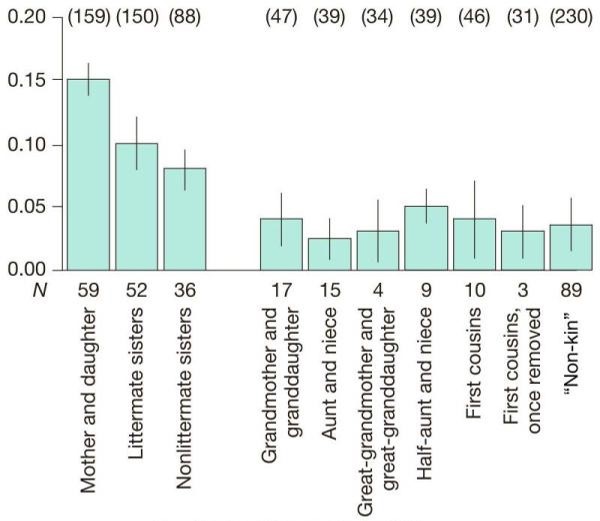Does the theory go along with the practice?
Like every theory we can make predictions and test them using Science. So according to Hamilton’s rule and Kin selection hypothesis we can formulate some predictions. The idea behind the whole story is that an individual wants to propagate its own genes as much as possible in the next generations (maximize fitness). And it doesn’t matter if it does that reproducing itself or helping kin to reproduce, the goal is the same.
But let’s stop and think about a detail that I still have to reveal. Me and my brother have a r=0.5 because we share 50% of the genes, but Me and Myself have a r=1 right? Of course I share 100% genes with myself. This is not a stupid play of words, it’s actually meaningful. Theory predicts, infact, that if I want to maximize propagated genes I should put an effort on it proportional to the grade of relatedness. This is simply because of propagation efficiency: reproducing myself and will propagate my gene more efficiently than helping kins to reproduce. So for example if I can reproduce myself pretty easily I will definetly decide to do it because I’m so related with myself that I don’t have a better strategy to propagate my genes. But if for some reasons I can’t reproduce myself, or doing it is too expensive I should help one of my kin to have children. But why preferring brothers over cousins for example? Of course, since we’re more closely related to brothers (r=0.5) we should first try to help brothers and then, if it’s the case, helping cousins (r=0.25); and so on for every kin. In summary, the higher the relatedness the bigger the effort I should put into propagating genes that way.

When parents and children don’t go along very well
So we finally come to what the post was all about: Parent-offspring conflict. Let me show why there’s a conflict using the idea of relatedness. Imagine that you’re a chick in a bird nest. You’re 100% related to yourself and 50% related to your mom and to all other chicks (brothers or sisters). On the other hand the mother bird has a relatedness of 0.5 toward every chick in the nest. You can already see that there’s a conflict in the reciprocity of effort that every character should invest. For example if I’m being fed by my mom while I beg (chicks crying to call for food) in my nest I want to have at least double the food compared to my brothers/sisters because I’m doubly more related with me than with them. While my mom wants to give the same quantity of food to everybody since she’s equally related to all. This generates a conflict in 2 perspectives: between mom and me and between me and my siblings.
The conflict between me and my mom regards more the quantity of food I should receive. I want a lot but she wants me to have the same as all the others. This leads to the weaning period. A period of time in which I want more food than the one that my mom will provide, so basically my mom is restricting my diet because the costs for her to give me more will be too high. It’s pretty cool to realize that even if mother and siblings should “care for each other” according to our conception, they are actually in conflict. After all, mother and siblings are being selfish in pretending as much food as they can.
There is always a fight between brothers
The other conflict is between siblings. For the same reason I want more food than my siblings because I share more genes with myself than with them. Such struggle normally leads to “competitive” loudness of begging between chicks. But other costs can limit the loudness if the chicks are highly related. However, this conflict can lead to extreme scenario, and we have plenty of examples. This is the case of siblicide: siblings killing one another. If you think about it, it makes sense: I want more food so much that the competition amongs siblings is so high that can lead to death. What is not clear in this story is the role of the mother. According to this theory she should prevent siblings from killing each other because she’s equally related to every chicks. And in some case this happen, the mother moderate aggressive behaviour among chicks, but in some other cases she seems to favor it or be neutral toward it. We have several hypothesis for that but we won’t go into details.
How many children should I have?
Another example of Parent-Offspring conflict is clutch size (how big should my eggs be?): there is a trade-off between the number of eggs a parent can lay and the size of them. The bigger the eggs, the less she can produce. What does the offspring want? Being as big as possible, because if you’re big the chances to survive are grater. What does the mother want? An intermediate size to optimize number and size of her egges so she can grow as many capable-of-surviving children. As you can see conflicts are everywhere even where they are not evident.
You know see hidden conflicts predicted and proven by experimental evidence present all around us. Next time you see a nice bird family don’t think that everything is nice and easy; there’s a war going on.
In the next post we’ll see how similar conflicts are present between the two sexes of parents especially when raising offspring is involved. We will see how this can occur both at the behavioral level and at the molecular level. Let me tell you another story..

Leave a comment